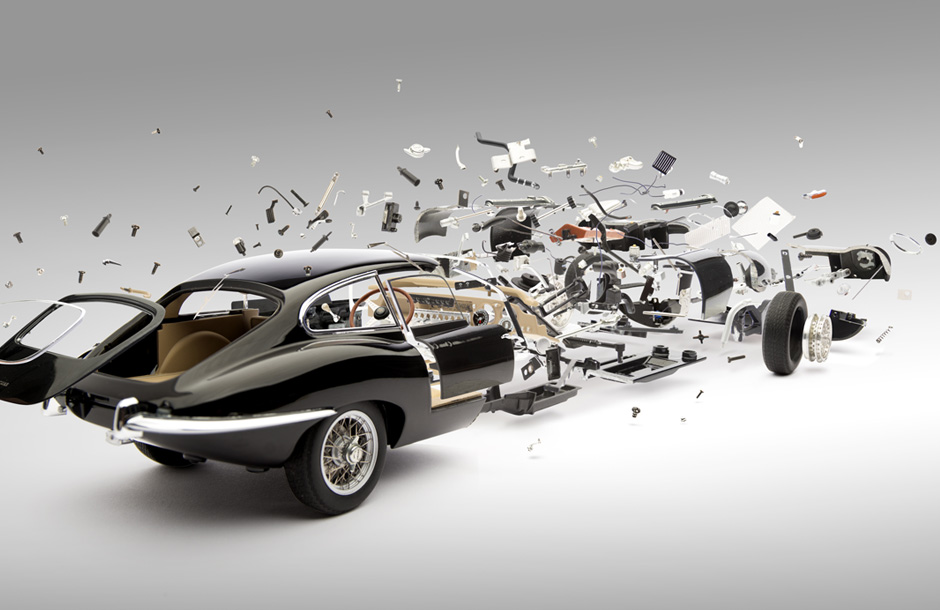
fabian oefner
Swiss artist Fabian Oefner has carved out his reputation by fusing the fields of art and science, creating images appealing to heart and mind. He first intended to become a car designer, but in the end, photography made a bigger impression on him.
In 2008, at 24 years-old, he got a degree in product design at FHNW in Switzerland before becoming a product photographer at Leica Geosystems.
Since 2012, Oefner runs his own photo studio in Aarau (40 minutes away from Zurich) where he undertakes projects from around the world. He is constantly on the lookout for capturing life moments that are invisible to the human eye: phenomena like sound waves, centripetal forces, iridescence, fire and even magnetic ferrofluids, among others.
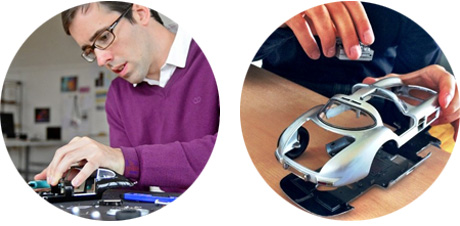
When did it all start? What was the trigger for your success?
When I was 14, I saw the image of Harold Edgerton with the bullet piercing an apple that fascinated me. It was taken with a camera equipment worth half a million dollars! (Edgerton invented the high speed flash at M.I.T.) Then I got my first camera, I was 15, and started investigating on how could I get such an impactful and visual effect on a low, barely existing budge
What is your motivation in doing what you do?
Finding out about what surrounds us and raise people’s curiosity
You are often called or compared to a scientist / an artist: which one do you prefer the most?
An artist! Scientists interpret phenomenon rationally whereas artists interpret them with emotions. I feel much more connected to art than science.
What is the satisfaction you get at the completion of an image?
The best thing I could hear is: “Your images inspire me in looking at things with a different eye.”
disintegrating series
Always on the lookout to catch the invisible, Oefner constantly looks for new ways to capture moments that are too fast for the human eye.
The Disintegrating series – representing a staggering amount of work- has been created from hundreds not to say thousands of shots. Each car has been dismantled completely, from the body shell to the smallest screws, then photographed piece by piece in a specific position to obtain the illusion of an exploding car.
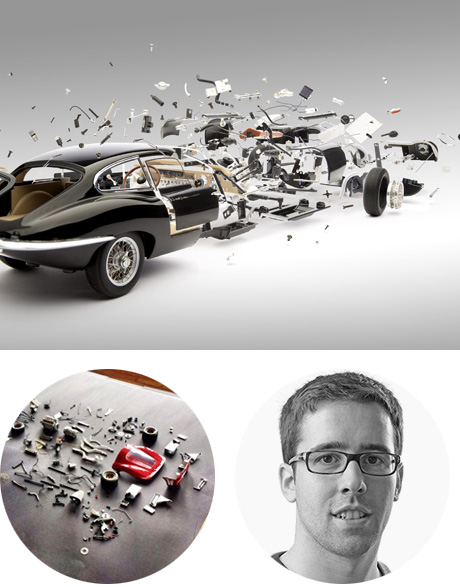
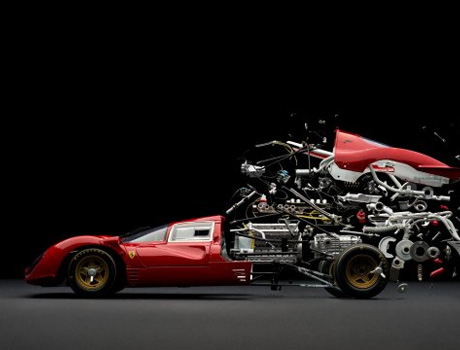
Disintegrating is about inventing a moment in time.
“What you see in these images, is a moment that never existed in real life,” says Oefner. “What looks like a car falling apart is in fact a moment in time that has been created artificially by blending hundreds of individual images together. There is a unique pleasure about artificially building a moment… Freezing a moment in time is stupefying.”
The images show exploded views of classic sports cars: intricate scale models of an eye-wateringly beautiful Mercedes-Benz 300 SLR Uhlenhaut Coupé with gullwing doors (1954); an iconic sleek, black Jaguar E-Type (1961); and a curvaceously sensual Ferrari 330 P4 (1967) as shown also at the top of the article.
We hope to have the pleasure of welcoming you to the gallery to share these detonating creations with you!
- Limited edition of 25 prints per image
- Unique size:120 cm X 70 cm
- Price: 1’900.- CHF inc. VAT
hatch
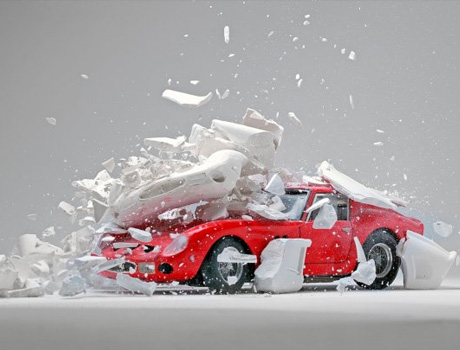
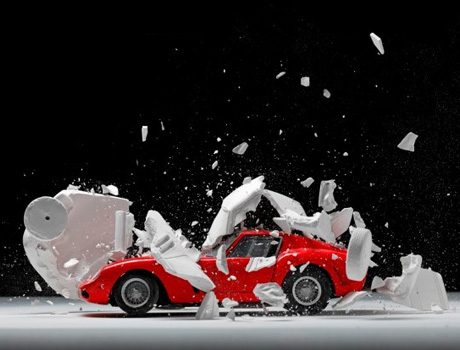
With Hatch, Fabian Oefner presents his interpretation of how cars might be ‘born’. The first two images show a Ferrari 250 GTO (1962) – again a detailed scale model – breaking out of its shell. The third image shows one of the empty shells left behind among several others yet to hatch.
For the Hatch series, Fabian started by making a latex mould from the model car, which was then filled with a thin layer of gypsum to create the shell.
Several dozens of these shells were made in order to complete the next step: smashing the shell onto the car to create the illusion of the vehicle breaking out. This step had to be repeated a great many times until the desired results were achieved.
To capture the very moment where the shell hit the model, Fabian connected a microphone to his camera, a Hasselblad H4D, and flashes, so that every time the shell hit the surface of the car, the impulse was picked up by the microphone which then triggered the flashes and the camera shutter.
Representing a car as a living, breathing organism that has been gestated is a neat twist on car conception; it could be said Hatch is to the automotive world what a stork is to delivering babies.
- Limited edition of 25 prints per image
- Unique size: 120 cm X 80 cm
- Price: 1’900.- CHF inc. VAT
making of...
Someone who doesn’t know and doesn’t care about how these images have been made assume it is by computer software exclusively. The way it really works is much more complex, flabbergasting and interesting!
For the Disintegrating series, Fabian first sketches on paper where the individual pieces would go, before taking apart the model cars piece by piece, from the body shell right down to the minuscule screws. Each car contains hundreds of components.
Then, according to his initial sketch, he places each piece individually with the aid of fine needles and pieces of string. After meticulously working out the angle of each shot and establishing the right lighting, he photographed the component, and took thousands of photographs to create eachimage of the series.
All these individual photos were then blended together in post-production to create one single image. With the wheels acting as a reference point, each part was masked in Photoshop, cut and then pasted into the final image.
“These are possibly the ‘slowest high-speed’ images ever captured,” says Fabian. “It took almost two months to create an image that looks as if it was captured in a fraction of a second. The whole disassembly in itself took more than a day for each car due to the complexity of the models. But that’s a bit of a boy thing. There’s an enjoyment in the analysis, discovering something by taking it apart, like peeling an onion.”
However, he adds: “The hardest part was actually setting up the camera, lens and light, because the biggest frustration is when you can't get any beautiful image out of it!”
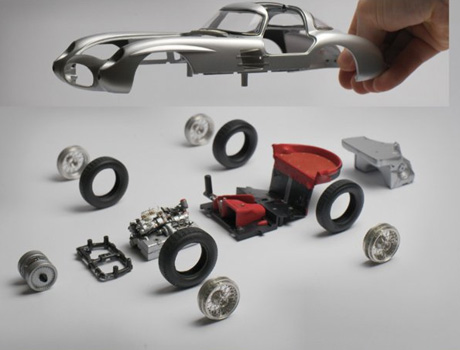
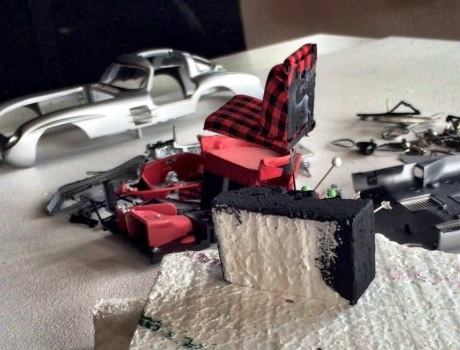
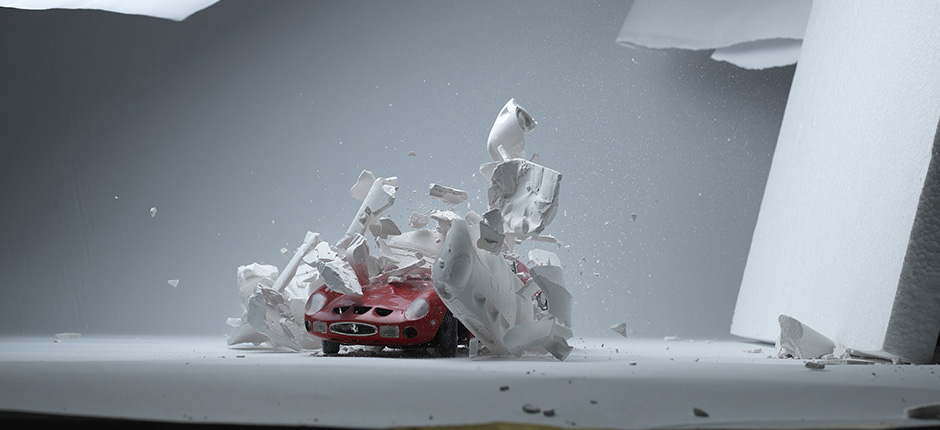
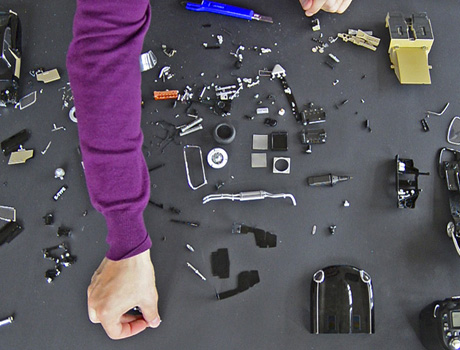
it takes two months to create an image that looks as if it was captured in a fraction of a second.


